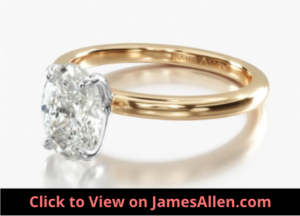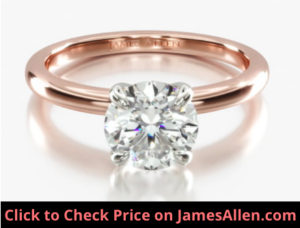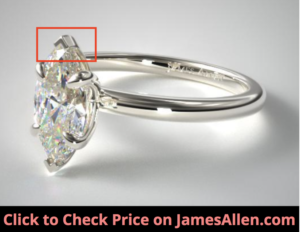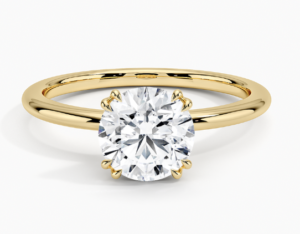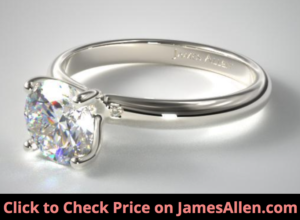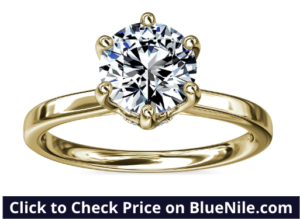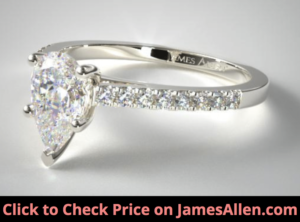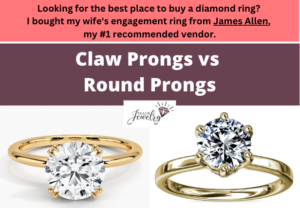
The main difference between claw prongs and round claws is claw prongs have pointed ends that grasp the crown of the diamond. Round prongs also stretch over the girdle but have a rounded end that secure the diamond onto the setting.
We’ll compare claw prongs versus round prongs, including an overview of each, pros and cons, and how to decide which is best for you.
What are Claw Prongs?
Claw prongs have pointed ends that reach over the diamond’s girdle and grasp its crown. They’re wide at one end and narrow as it approaches the tip, mimicking a talon.
Check out this example of an exceptional claw prong setting from the vendor where I bought my wife’s engagement ring.
It’s elongated and often extends farther onto the diamond than other types.
In terms of style, claw prongs fall into the minimalist category. While some versions of prong settings feature six or eight surrounding the diamond, most claw settings include four prongs.
They fit multiple diamond cuts. Whether you’re considering an oval, radiant, emerald, or round cut, it can be held in place by claw prongs.
For example, this 14K yellow gold claw prong engagement ring features an oval cut.
There are four claws grasping it in a way that still exposes a significant amount of its table.
Claw prongs are an effective way to distinguish the setting from more classic types while still maintaining a sleek aesthetic.
Pros
Covers Fewer Facets
The primary advantage is it shows more of the diamond compared to round or flat tab prongs.
The way the prongs narrow as they approach the center of the diamond prevents them from hiding more of the table.
The image below showcases this feature at a helpful angle, and you can also rotate the image 360 degrees on the vendor’s website.
Specifically, it’s easy to see how the two prongs on the bottom start wide and then narrow.
It enhances the brilliance of the diamond because more light can enter and exit. This is especially true for diamonds less than one carat.
Security
Claw prongs are often more secure than other types because they farther reach across the diamond.
As a comparison, V-prongs latch onto the sides of the diamond and don’t extend as far onto the table’s facets. They’re used to hold unique cuts like heart-shaped diamonds or the pointed ends of marquise cuts.
I’ve highlighted that feature in the below engagement ring.
But it’s worth noting that each major type of prong offers sufficient security, when applied correctly based on its cut. If you notice the diamond loosening or the claw prongs are bending backward, don’t wear the ring until it’s fixed.
Multiple Styles
There are also multiple styles of claw prongs. Petite claw prongs have the same shape but cover less of the crown and table.
They’re fit for small diamonds, when you don’t need as much strength to keep it firm on top of the setting. For large diamonds, we recommend standard claw prongs instead of petite ones.
Another type of claw prongs is called split prongs.
As it narrows toward the bottom, the claw splits into two. They’re still attached at the base, but it adds a more modern aesthetic.
You can also secure your diamond with a double claw prong setting, which often features four sets of two claws.
It’s a sleek design that’s fit for diamonds larger than one carat.
To illustrate, check out the example below of a double claw setting holding a round-cut diamond.
If the eight total claws were equidistant around the diamond, it wouldn’t have the same effect and would instead appear like the setting is crowding the gem.
Cons
Price
The manufacturing process is more complex because it’s difficult to mass-produce their shape. It often results in a higher price.
As an example, we’ll compare two platinum settings, where one has claw prongs and the others are flat.
This claw prong setting costs $900, and these flat prongs cost $615.
The price of round prongs can fall in the middle.
The platinum setting with round prongs below costs $675.
There are always exceptions, but as a general rule, you’ll pay more for claw prongs.
Snag and Trap Debris
Claw prongs also have the potential to snag on everyday items. Their sharp ends can catch on clothing or furniture and bend the prong upward, which loosens its grip on the stone.
Even if one prong is loose or bent, you should have it repaired. That’s always easier and less expensive than replacing a lost diamond.
Buyers also report claw prongs trapping fuzz. Be careful removing any trappings to avoid bending the prongs in the wrong direction.
What are Round Prongs?
Round prongs mimic the shape of beads grasping the edge of a diamond.
In the example below, the round-cut diamond is held by six of them, set equidistant around it.
Like claw prongs, round prongs start from the shank and reach over the girdle, but instead of the pointed shape at the end, they’re rounded.
In most cases, round prongs don’t extend as far onto the diamond as claw prongs. It reaches far enough to provide the necessary security and is more comparable to flat tab prongs.
Here’s a comparison of each style, where you see how much farther the claws extend.
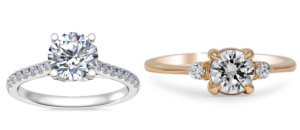
Round prongs work on almost every diamond cut, but buyers often favor V-shaped prongs for ones with pointed ends or corners.
For example, princess cut diamonds are often held in place by V-shaped prongs on its corners, while round prongs work for cuts such as:
- Round
- Heart
- Asscher
- Radiant
- Cushion
The same design can work for those other cuts as well.
Pros
Popular for Fancy Shape Diamonds
The first is they’re useful for fancy cuts like heart-shaped, pear and oval cut diamonds. The prongs latch onto their rounded edges to hold it in place without extending too far over it.
For example, this pear-cut diamond engagement ring features four round prongs and a V-prong.
The four spherical prongs shaped like buttons contrast with the pointed prong at the bottom. This contrast adds a unique element to the ring you won’t find when the same type of prongs are used throughout the piece.
Wider Selection
Round prongs are available in a wide selection of designs. You can select a four-, six-, or eight-prong ring, depending on the size of the diamond.
For example, this round-cut engagement ring in rose gold has six round prongs.
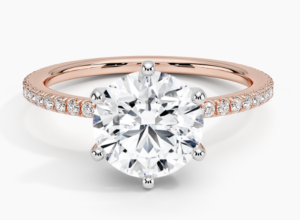
Eight-prong settings cover more of the diamond but have added security, or you can take the middle route and include six.
Four is sufficient in most cases. It’s uncommon for diamonds less than one carat to have more than four prongs.
The number of prongs can also depend on the diamond’s cut. A popular setting for round and cushion cuts has double button prongs.
On four edges, a set of two button prongs grips the girdle.
Cons
Hide Diamond Facets
One downside of this type of prong is they can cover more of the diamond than claw prongs.
The rounded tips don’t narrow as they extend over the diamond, so less of its facets are exposed in some places.
This isn’t an issue on large diamonds, but for smaller ones, any space taken up by prongs is less room for light to enter.
Lacks Uniqueness
The style also isn’t unique. Many buyers want an alternative to a traditional engagement ring, which often features a solitaire setting, round prongs, and a round cut diamond.
While there are many other ways to create an engagement ring, such as with a cathedral or Tiffany setting, channel set diamonds in the shank, or a fancy cut, if you’re looking for a more subtle shift, prongs are an option.
That’s where claw prong and V-shaped prongs become a suitable choice.
How to Decide Between Claw Prongs and Round Prongs

Buyers comparing claw prongs versus round prongs should understand what makes each unique and how they affect the overall performance of the ring.
Here are some guidelines to help you decide between the two.
Consider claw prongs for your diamond ring if:
- You want to expose as much of the diamond as possible
- You’re interested in exploring multiple styles, such as split, petite, and double claws
- You’re willing to pay a higher price compared to round prongs
Opt for round prongs if:
- You’re concerned about fuzz trapping underneath them or the risk of claw prongs catching on everyday items
- You want a classic style setting that mimics most engagement rings
- Round prongs covering more of the diamond won’t have a significant impact on its brilliance because of its size
By comparing a number of prongs and pairing them with a quality diamond, you’ll find the perfect ring for you.

Jacob Clarke
Jacob Clarke is the founder of TeachJewelry.com.
He earned an Applied Jewelry Professional Diploma from the Gemological Institute of America (GIA) and now brings you essential information about diamonds, settings, and more.
Jacob has consulted with leading jewelry brands, and his work has been cited in Clean Origin, Diamond Nexus and industry publications.
He's also a member of the International Gem Society.
He enjoys discussing jewelry with readers, so contact him with any questions at jacob.clarke@teachjewelry.com.

